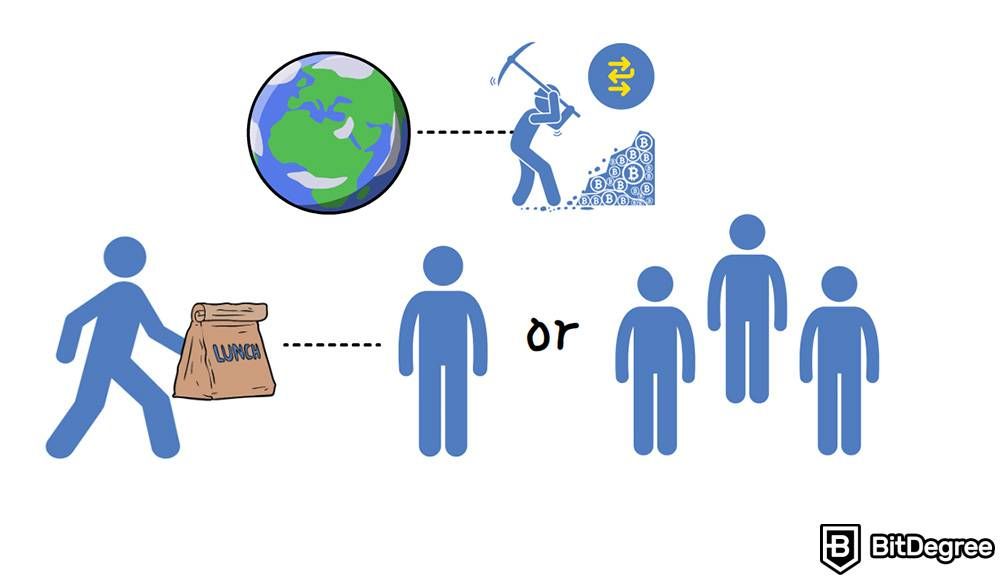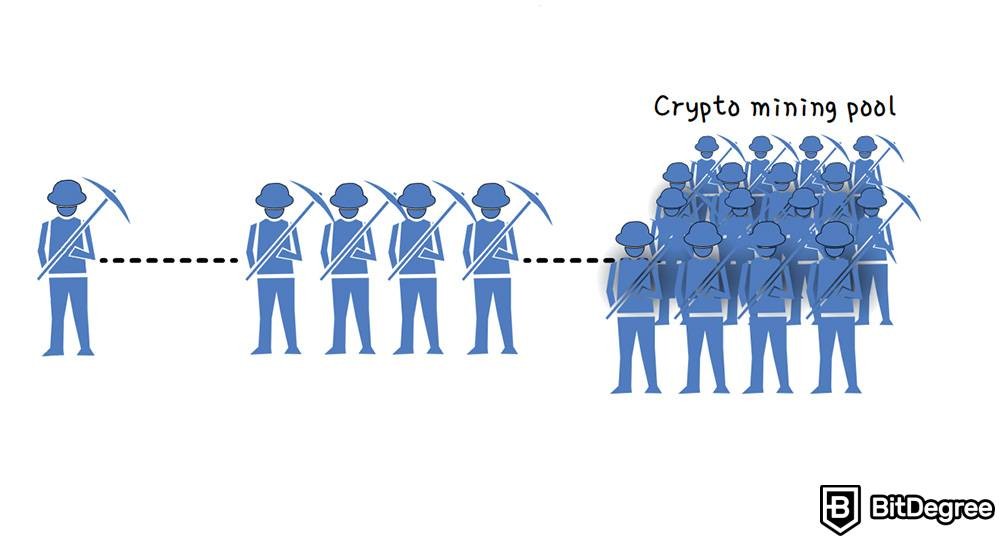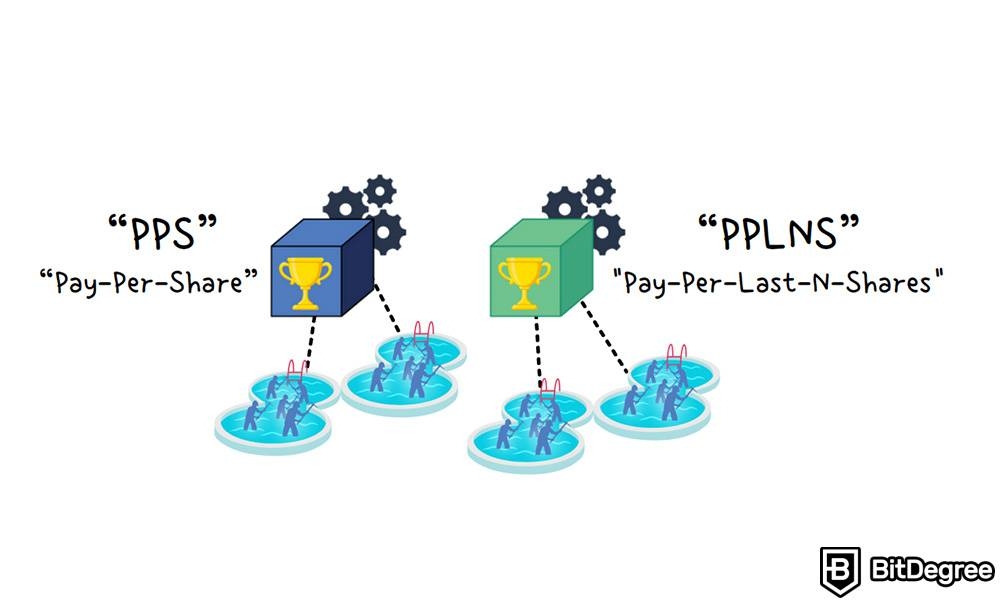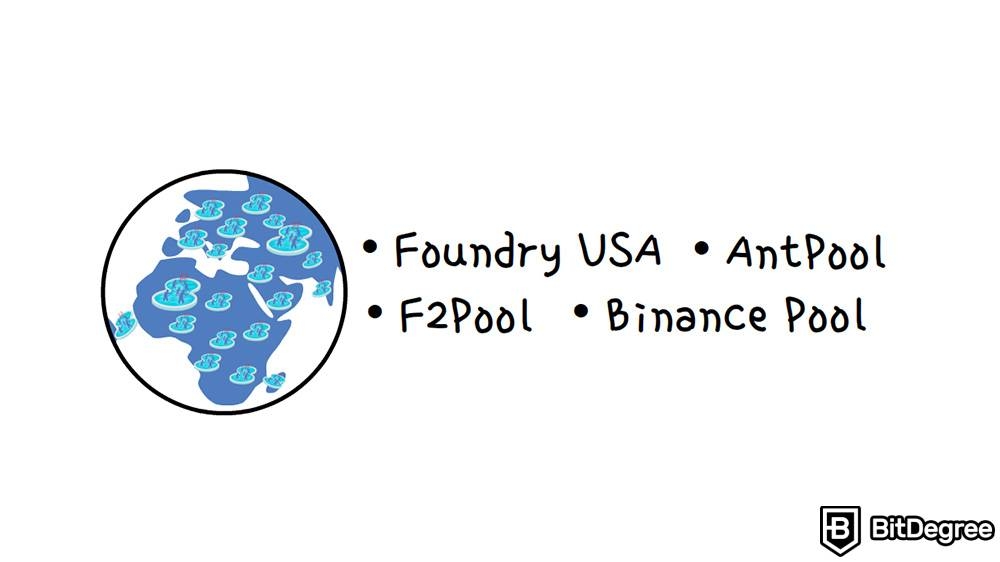9.2 Mining Pools: Is Collective Mining Better Than Solo Mining?
Stop overpaying - start transferring money with Ogvio. Sign up, invite friends & grab Rewards now! 🎁
In this section, we’re going to talk about what is a mining pool in crypto, how important are they, and how does a mining pool work, to begin with.
Mining pools are like another chapter in the book of crypto mining. In the previous section, I explained what crypto mining is, as such. Now, having discussed that, we can move on and venture into more complex topics, such as what is a mining pool, how to setup a mining pool, or simply, how to join a mining pool that’s already out there.
Mining pools are subject to fierce debates. On the one hand, they’re a natural result of the constantly intensifying competition in the crypto mining industry, on the other hand, certain crypto mining pools have become so huge, that some consider them a threat to decentralization, that’s supposed to be almost synonymous with DeFi.
In this section, we’re going to take a deeper look into the theory and practice of crypto mining pools, as well as answer the questions of what is a mining pool, how to setup a mining pool, and why they are so important.
Let’s dive into it!

Video Explainer
Video Explainer: Mining Pools: Is Collective Mining Better Than Solo Mining?
Reading is not your thing? Watch the "Mining Pools: Is Collective Mining Better Than Solo Mining?" video explainer
What is a Crypto Mining Pool? Is it Worth it? (Beginner-Friendly)


Different Types of Mining
So, just like with many things in life, crypto mining is something that can be done in different ways. It’s like going out for lunch. You can go alone, or you can go together with your co-workers. You’ll see what I mean in a minute.

But before we get into specifics, let’s speedrun the definition of what is crypto mining.
So, cryptocurrency mining is an inseparable process of many important blockchains, such as the Bitcoin network, as it ensures the network's efficiency and security. It consists of validating and verifying transactions that take place on the blockchain, and adding them to the blockchain's public ledger.
Crypto miners use specialized hardware and software to solve complex mathematical problems, known as hashes, that secure the network. They receive rewards for doing so.
And, as I’ve already mentioned, crypto miners can venture into this adventure alone, or they can join a crypto miner collective, which is also known as a crypto mining pool. Let’s define the difference between these two approaches.
Individual Mining (Solo Mining)
So, first of all, let’s talk about individual mining, which is also known as “solo mining.” Let’s rely on a very simple real-life example.
Imagine going on a beach with a metal detector. You may go on exploring, and eventually stumble upon a lost watch, some coins, or similar stuff. But, as it has happened before to some lucky people, you may find a long-lost buried Roman treasure, waiting for some random metal detector hobbyist to unearth it.

Here’s the catch. You found it on your own. It’s yours. You invested into the necessary gear, you found the time, and you went for it. That’s an investment. And, as a result, whatever you may find, will be yours. Founders keepers, after all.
The same applies to individual mining. It involves a single miner investing and using their own resources in this activity, and, therefore, reaping the fruit of their labor for themselves. These resources are your own money, the required mining hardware and software, computing power, electricity, and time.
Individual miners run their mining equipment independently and, as a result, receive the full rewards. Of course, this happens only in cases when they’re the ones to successfully mine a new block, and receive the block reward.
But, as the industry grew, mining became a rather competitive concept. This resulted in individual mining becoming expensive, risky, and not-that-profitable anymore, as it used to be.
Of course, this is only true when talking about mining such coins as Bitcoin. There are other coins that rely on mining, and mining them remains less risky and more profitable, even to this day.
But, receiving the block reward for mining a new coin is way more valuable and profitable, when the block reward is literally newly-mined Bitcoin. Therefore, many miners chose collaboration, instead of confrontation.
As the saying goes: “If you want to go fast - go alone. But if you want to go far - go together.”

Therefore, many individual crypto miners decided to combine their powers, which significantly increased their chances of successfully finding the hash, mining a new block, and receiving the reward. They form, or join, a mining pool.
The downside of this is simple. The reward will have to be shared among those who together constitute the mining pool. But the logic here is obvious - even though the rewards will have to be shared, the chances of receiving them are higher. Therefore, you may receive less, but this should happen more often.
Mining Pools
So, mining pools are the opposite of solo mining. It’s literally just collective mining.
Let’s get back to the previously mentioned metal detector analogy. Imagine going out to search for hidden treasures on some random beach. But this time, you’re going with a friend.
However, there’s a minor, yet important detail. Your friend lends you one of his metal detectors, since you don’t have one of your own. So, you go out, the stars align in your favor, and you find a lost, yet still running, Rolex watch that’s worth at least $20K.

Even though you may be the one who found it, it’s a result of collective activity. And you’re most definitely sharing the profit that comes from selling the Rolex. If it wasn’t for your friend who gave you the necessary equipment, you probably wouldn’t have found the watch.
So, in its dry technical definition, collective mining involves multiple miners combining their computational power and other resources to significantly increase their chances of successfully mining new blocks, and receiving rewards.
The rewards are distributed among the participants based on their contributions, since different crypto mining pool participants contribute unequal amounts of resources.
Reward Distribution Methods in Mining Pools
But, as it’s always the case with anything crypto-related, things always get more complex. Distributing miners’ rewards is no easy task. Therefore, it’s important to take a look at the architectural principles that are integrated into different kinds of mining pools.
In order for a mining pool to run smoothly, and for the distributional mechanism to make no mistakes, mining pools must rely on certain organizational principles. Therefore the question of “how to set up a mining pool” is technical and complex and, thus, requires a deep understanding of this technology.
Apart from the technological aspect, the organizational one is also of paramount importance. Mining pools rely on coordinators who oversee the sophisticated block reward distribution processes.
Most mining pools apply one of the following reward distribution methods. The first one is called “PPS”, which stands for “Pay-Per-Share,” while the other one is Pay-Per-Last-N-Shares, or “PPLNS,” in short.

The PPS method is a reward distribution model where miners receive a fixed payout for each share they contribute to the mining pool, regardless of whether the share ultimately leads to finding the right hash, which would lead to block creation.
This “share” refers to the individual miner’s contribution to the mining effort. In this case, you can view this method as rewarding the employee with a regular salary. The obvious pro of this method is the stability of the income that miners receive.
Often, you’d see that many prominent pools use a “PPS+” reward distribution method. It means that the whole distribution principle is the same, but it’s just a little bit enhanced. Such reward systems incorporate transaction fees into the reward calculation. These fees come from blocks that miners contribute to.
The Pay-Per-Last-N-Shares method, on the other hand, takes a different approach. In PPLNS mining pools, miners get rewarded every time the mining pool succeeds at creating a new block. In such cases, they get rewarded according to the number of shares that miners contributed to this success. The “N” in “PPLNS” here stands for this number.
So, essentially, in PPLNS, miners who contribute more, get more rewards.
How to Join a Mining Pool
By now, we have laid out the theoretical background behind what is a mining pool. Let’s take a look at some real-life examples, and how to join a mining pool.
Among some of the world’s biggest mining pools are such names as Foundry USA, AntPool, F2Pool, and Binance Pool. These giant pools control a lot of the computational power, and, as a result, they have a lot of influence over the network. For example, Slush Pool has over 200,000 registered users, and mines several different cryptocurrencies.

And, if you take a look at AntPool, you can see that this mining pool offers both reward distribution methods to their users, be it PPS+, or PPLNS. It depends on a person's preferences and financial situation. So, the options are not strictly limited.
Now, the answer to the question of “how to join a mining pool” is rather intuitive. After setting up a crypto mining rig, a person has to check whether their hardware is compatible with the mining algorithm used by a particular mining pool. Then, everything goes the usual way.
To put it simply, it consists of creating an account, connecting to the pool, setting up a crypto wallet, monitoring the process, setting up a payout method, and, ultimately, withdrawing your earnings. Of course, this is an oversimplification of the entire process.
Mining Pool vs. Mining Farm
Finally, there is one more aspect of this topic that requires addressing. It’s the difference between the two seemingly-similar, yet different concepts. I’m talking about “mining pools” and “mining farms.” They refer to two different things; therefore, it’s important not to confuse them.
By now, “what is a mining pool” is something that I’ve already answered. But, to put it in the shortest possible way, it’s combined computational power in an effort to increase the chances of earning block rewards.

Now, a mining farm refers not to the fact of a collective mining effort, but to the physical location of where a large number of mining rigs are located. It can be huge, yet set up by a solo miner.
Similarly, a single crypto mining pool can consist of many crypto farms that would all be collectively trying to fetch that block reward.
Wrapping Up
Alright, we’ve reached the end of the section! Crypto mining pools are a deep subject, and, hopefully, I’ve answered many questions that may have bothered you. To learn more about the crypto world as a whole, make sure to check out other chapters in this Crypto 101 Handbook.










